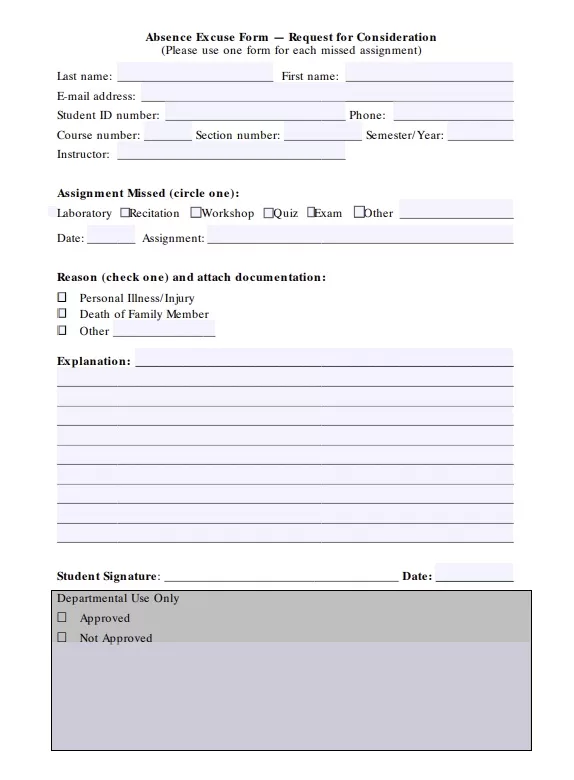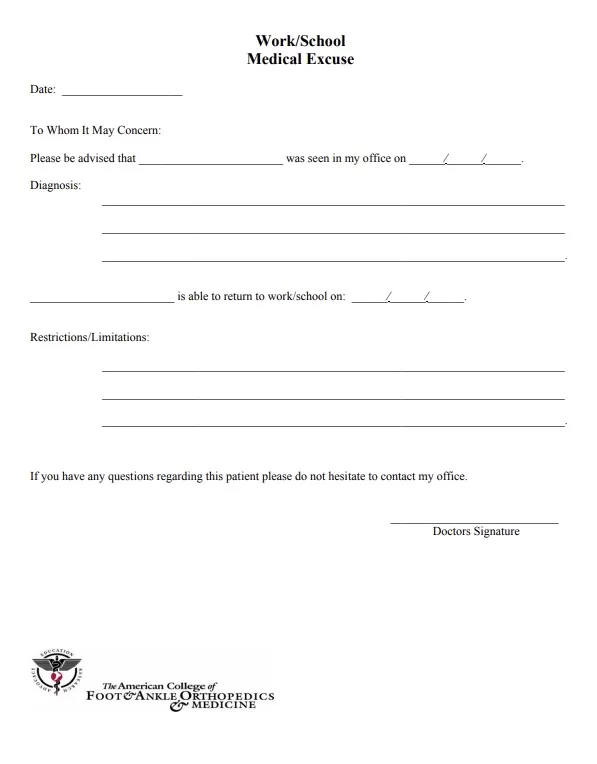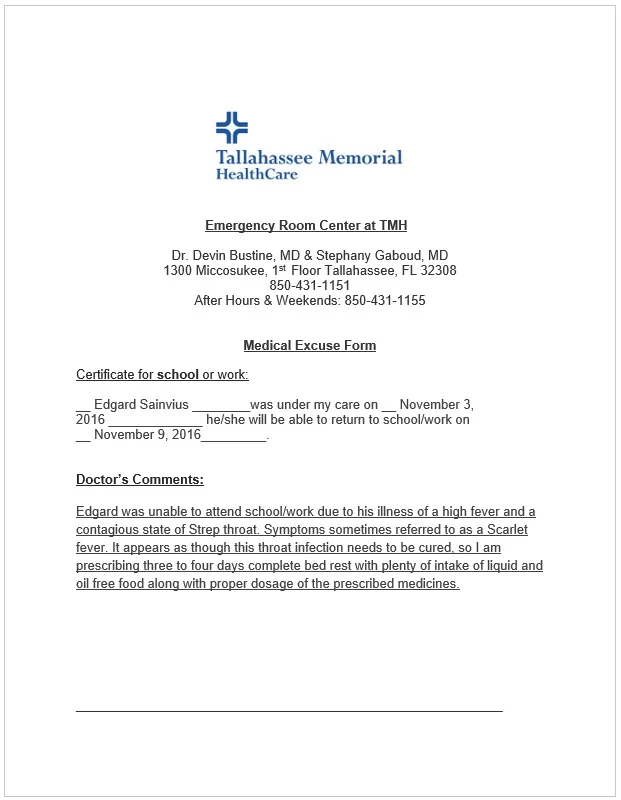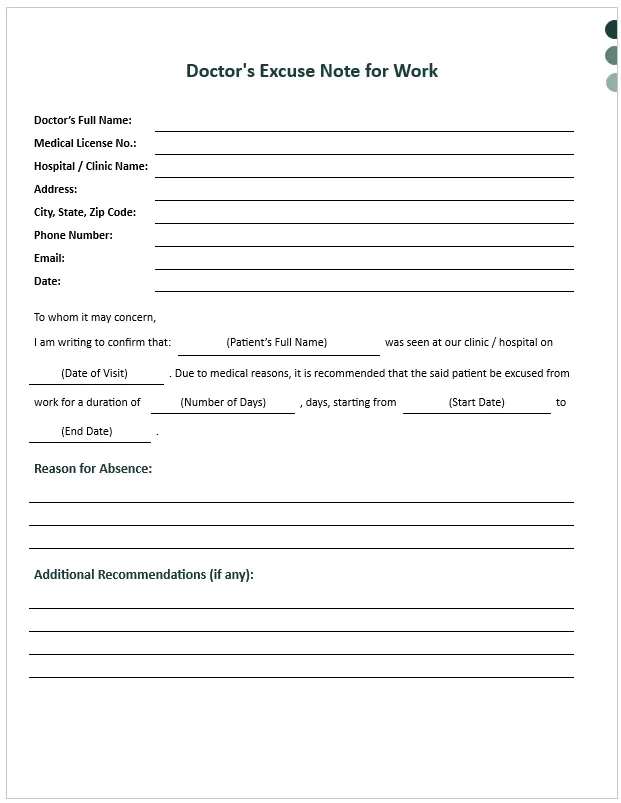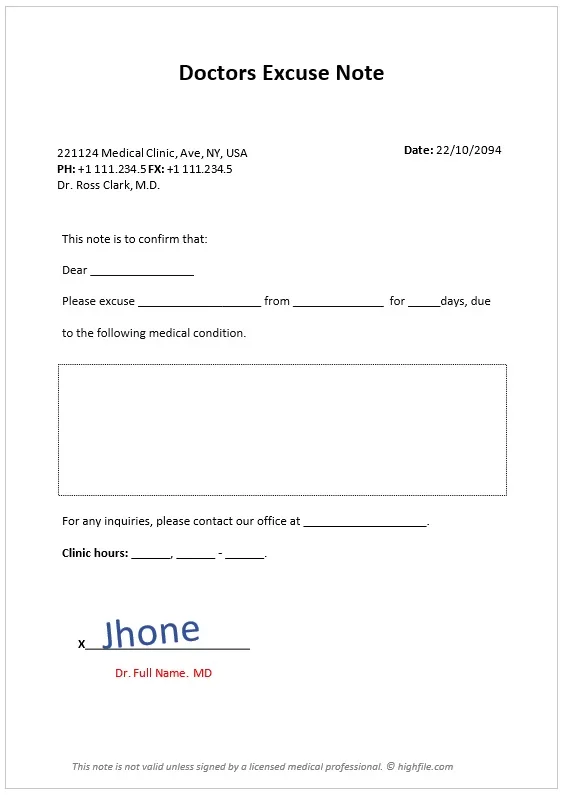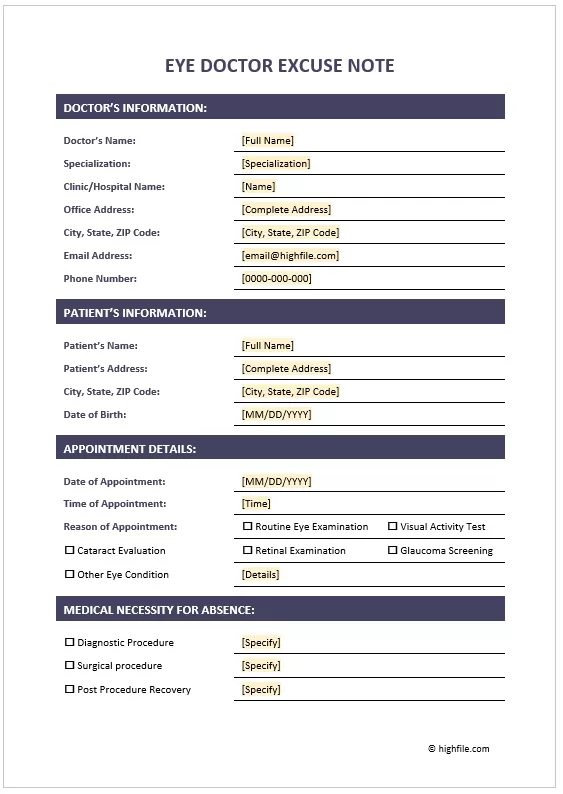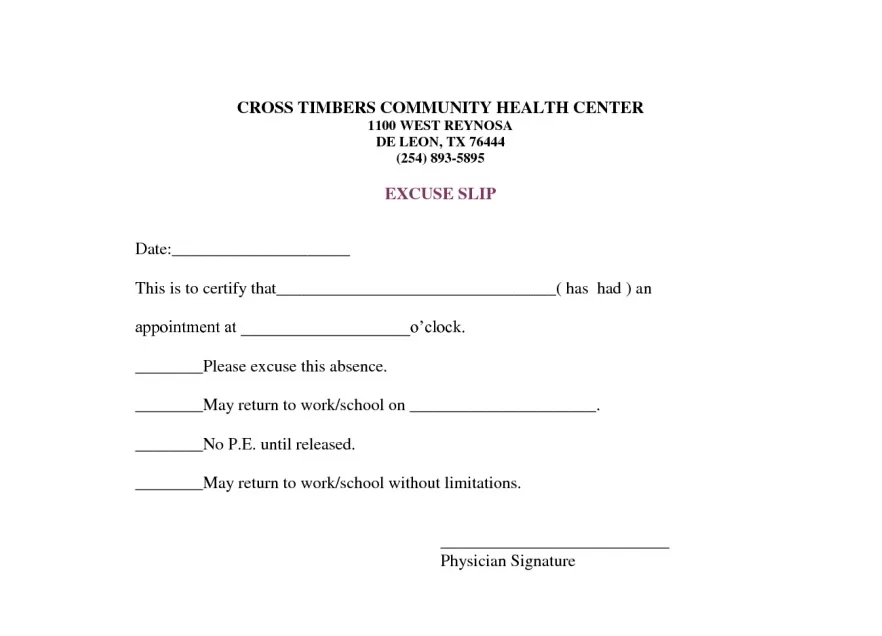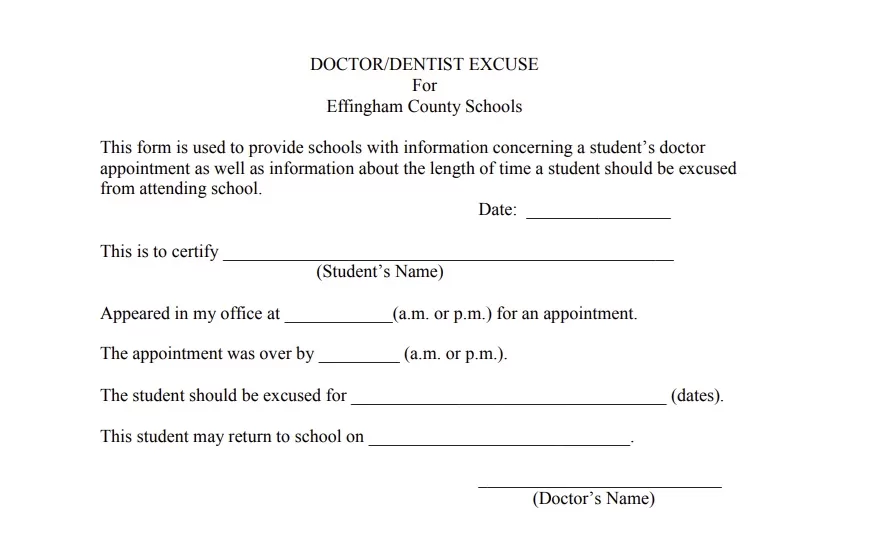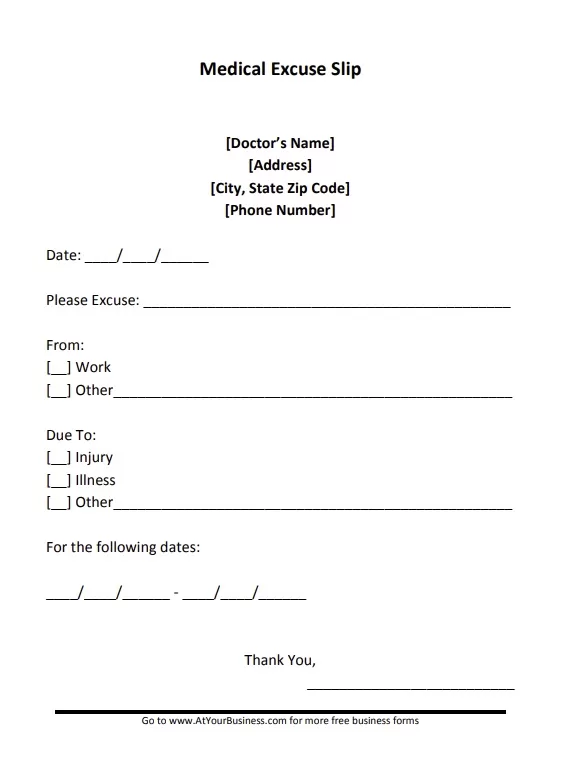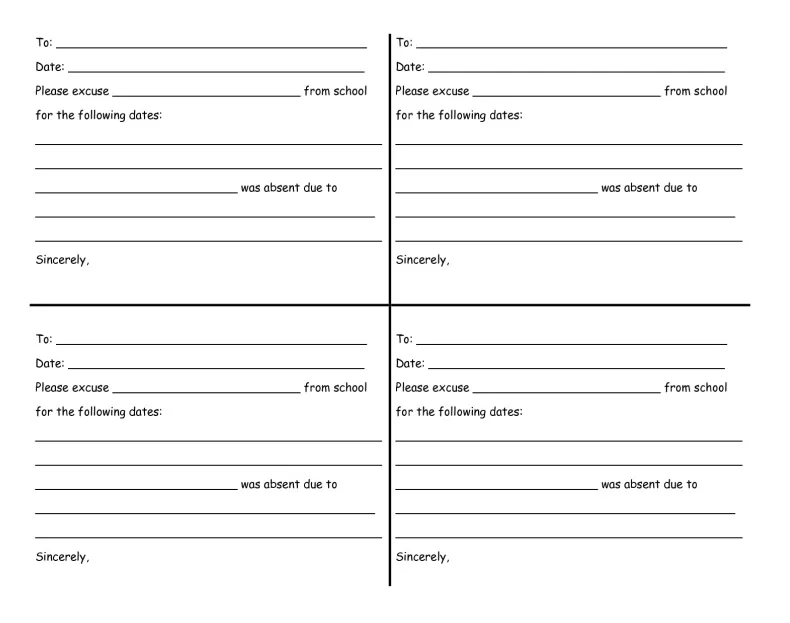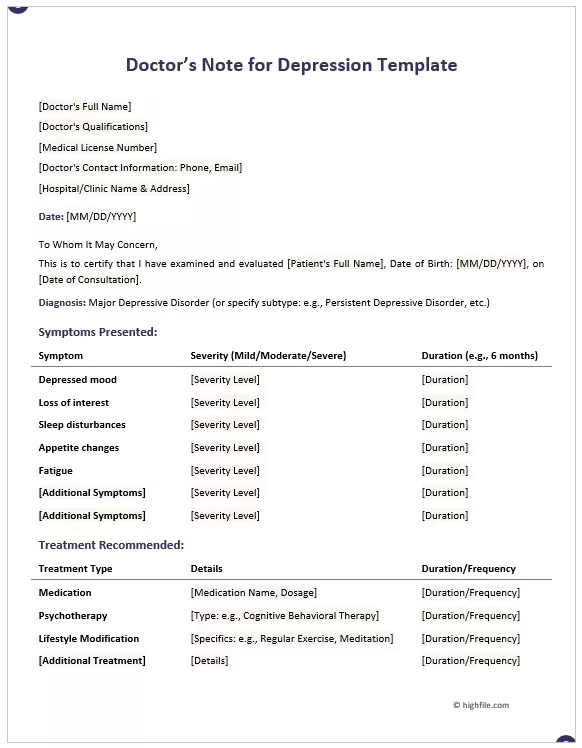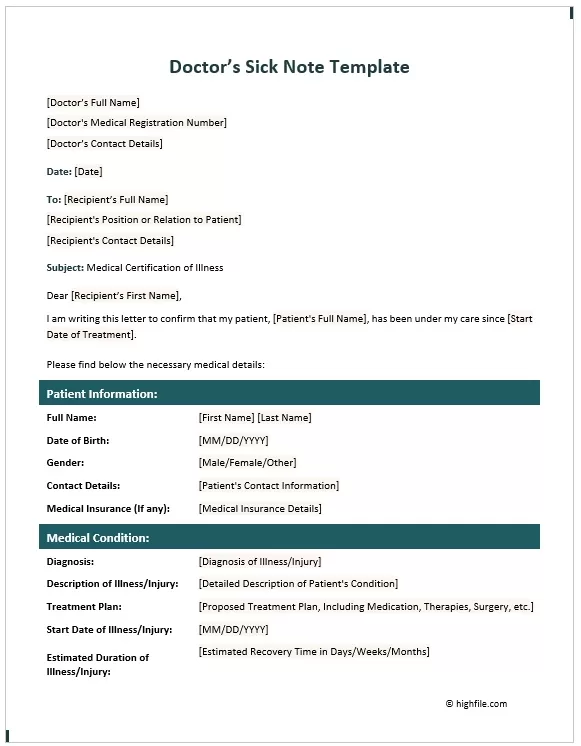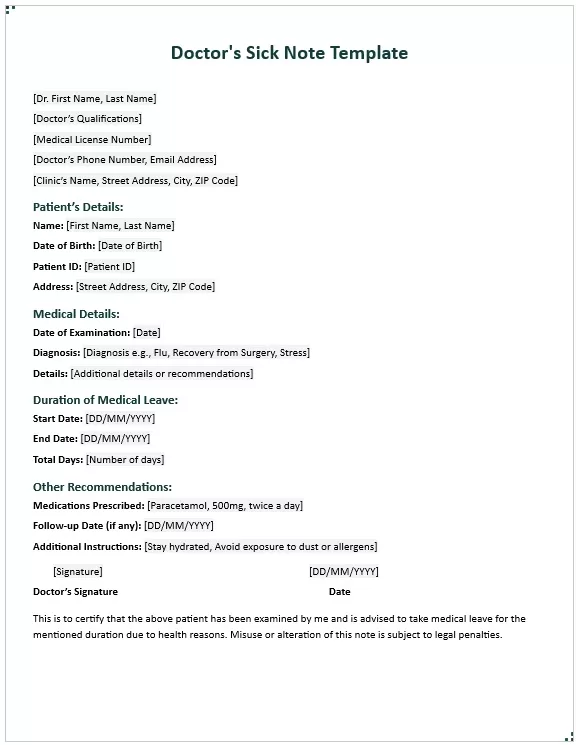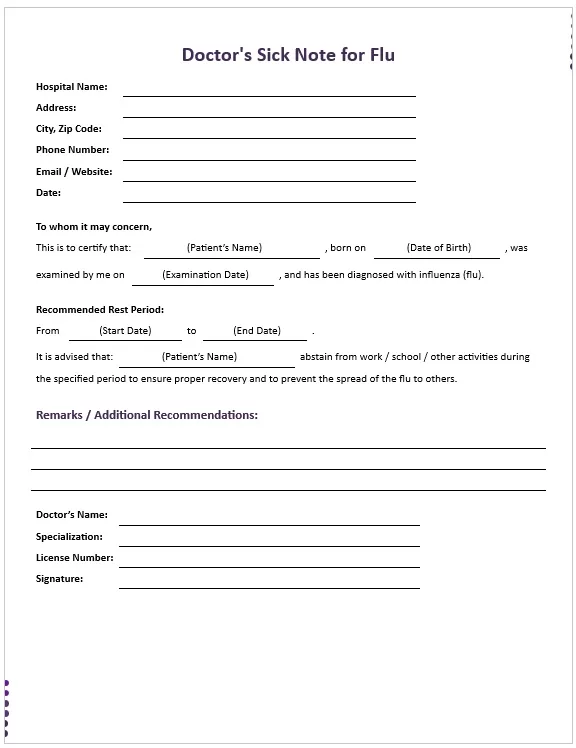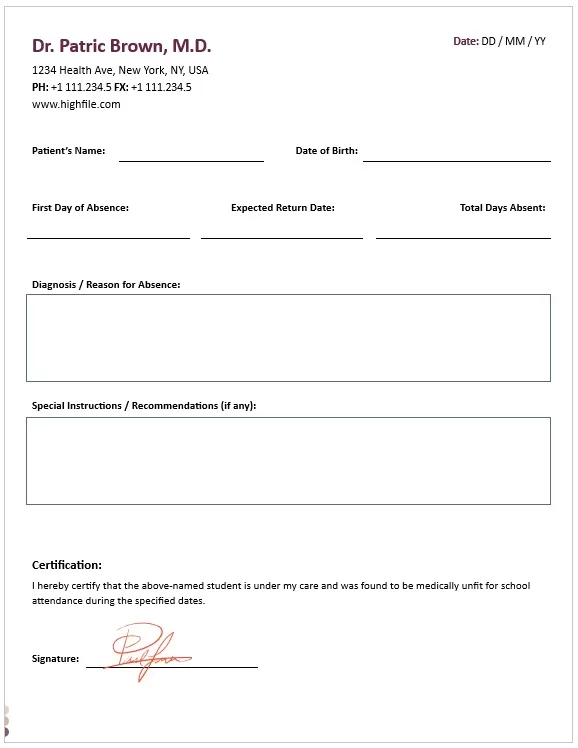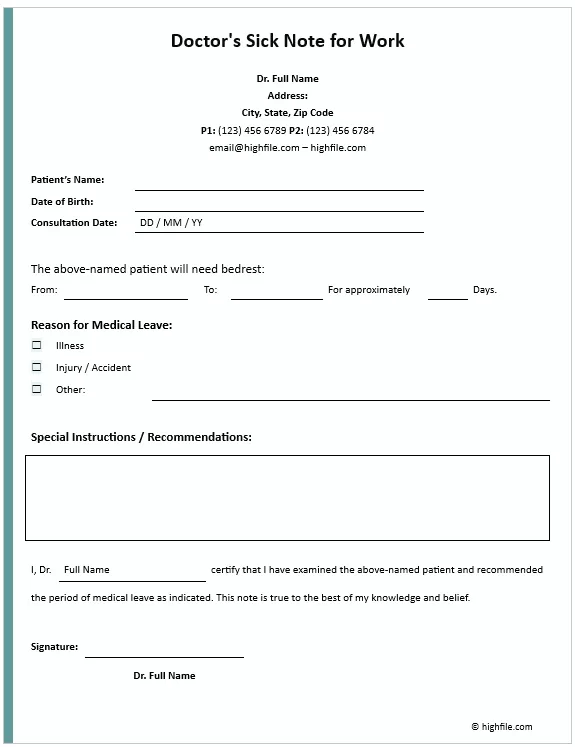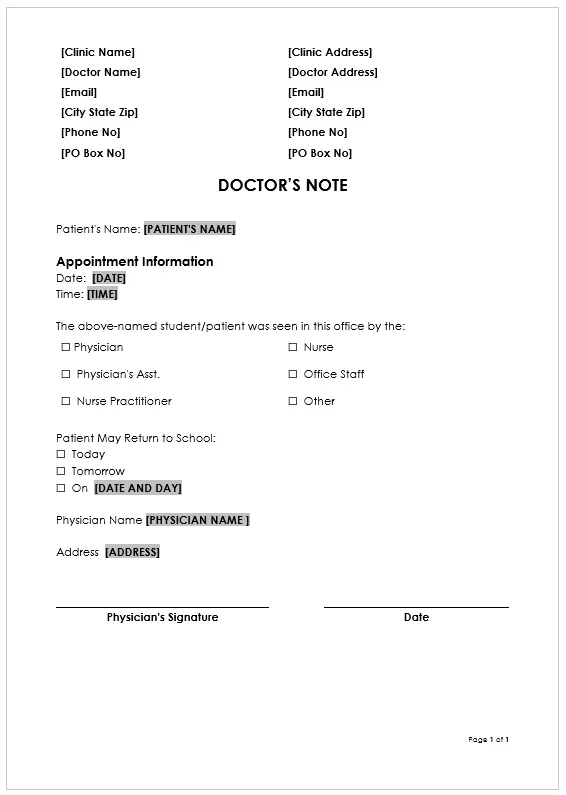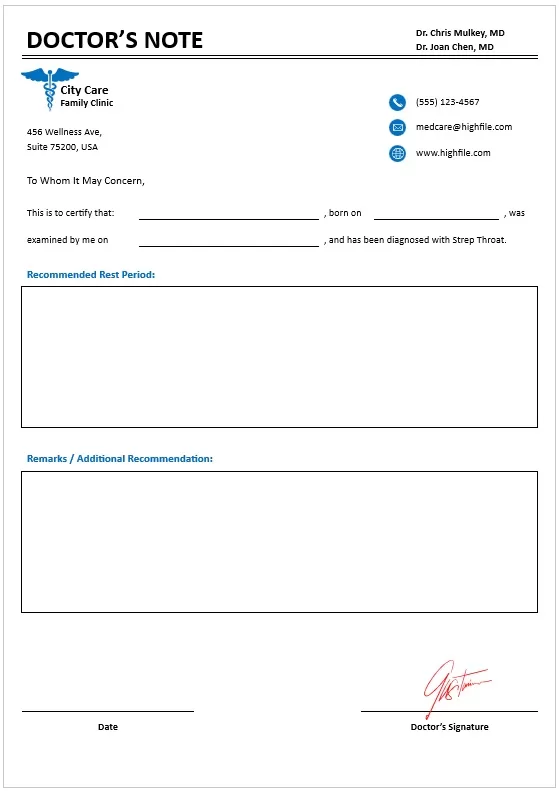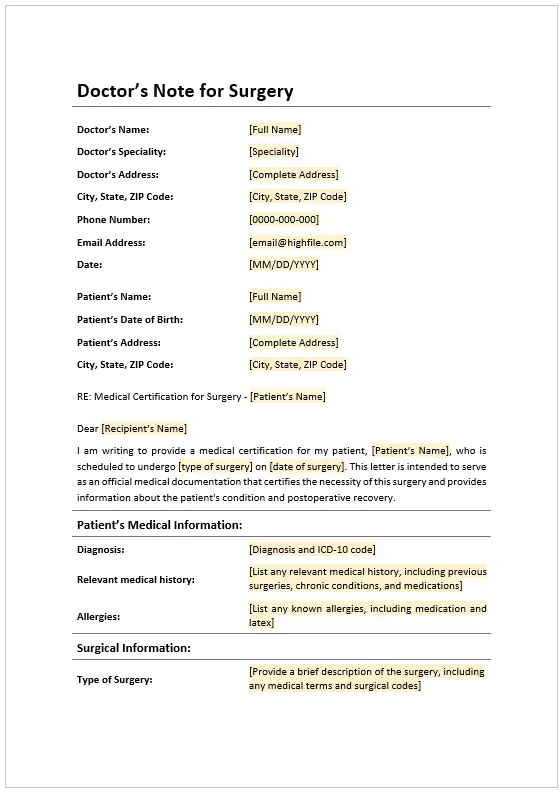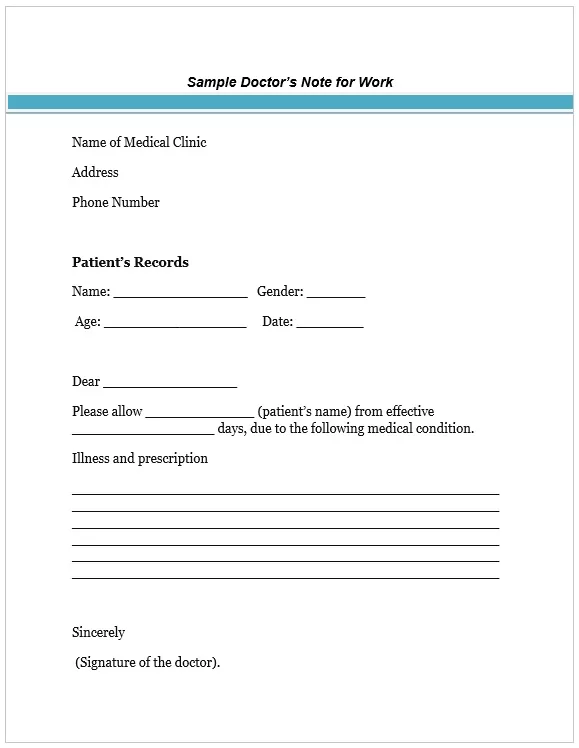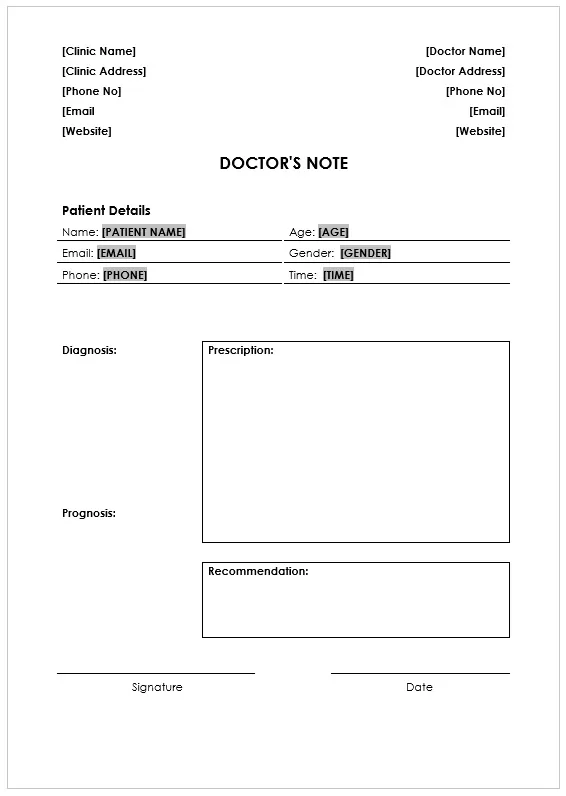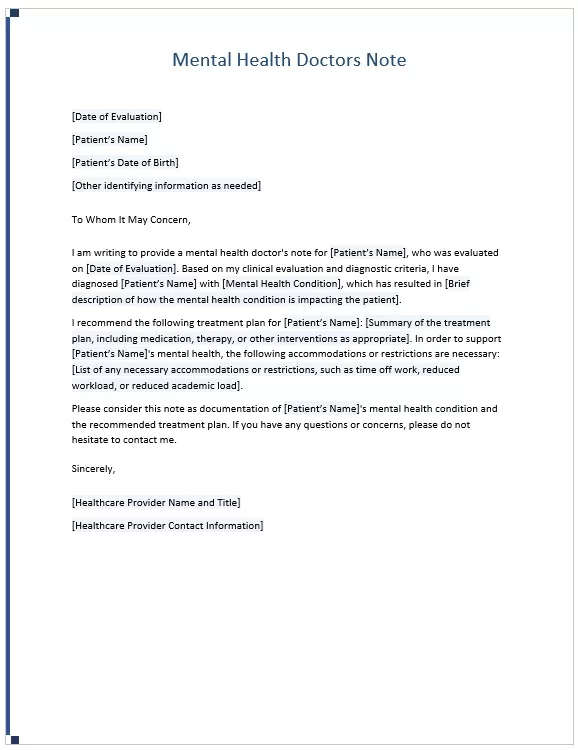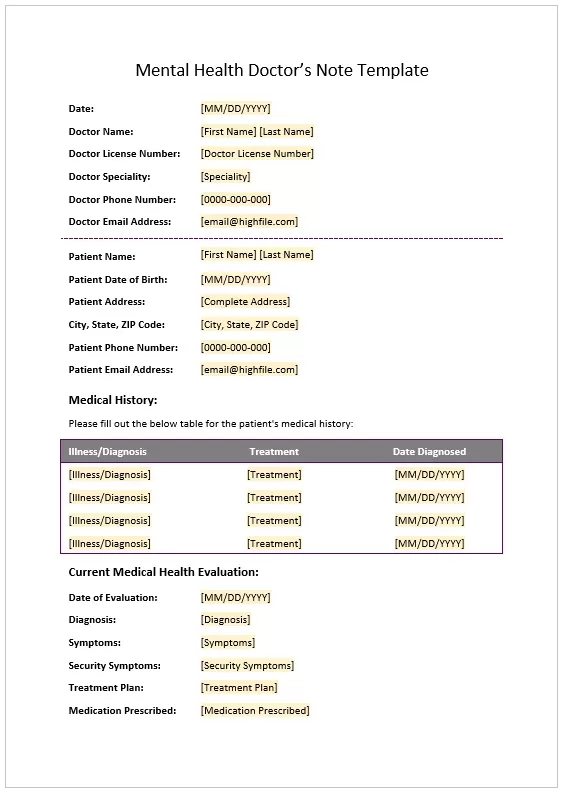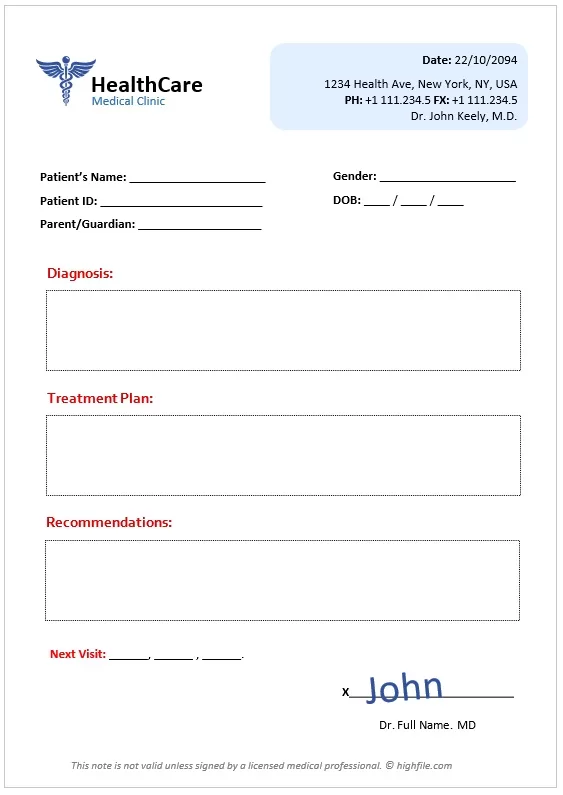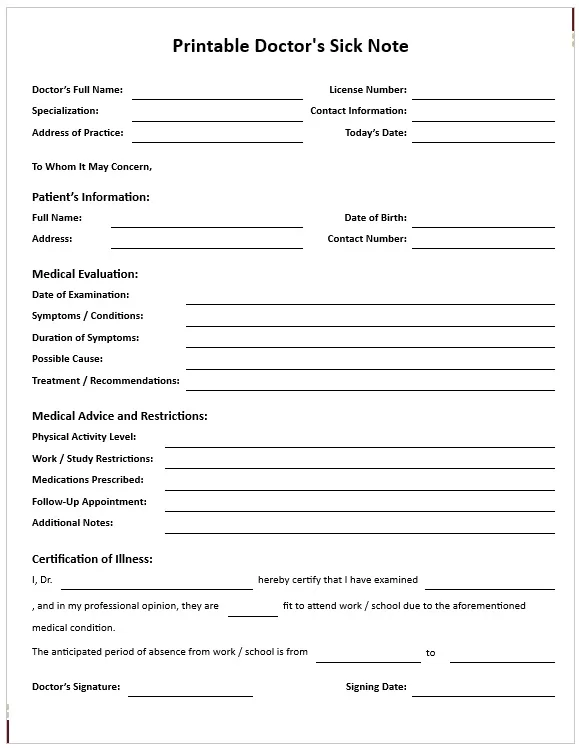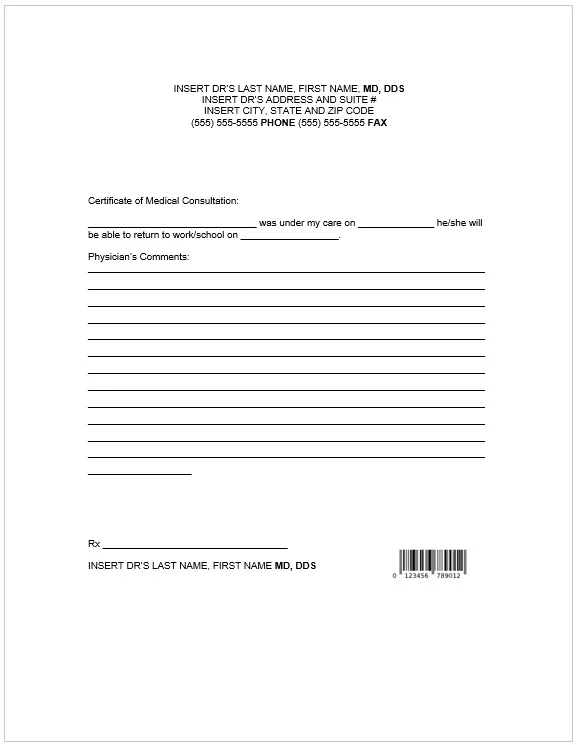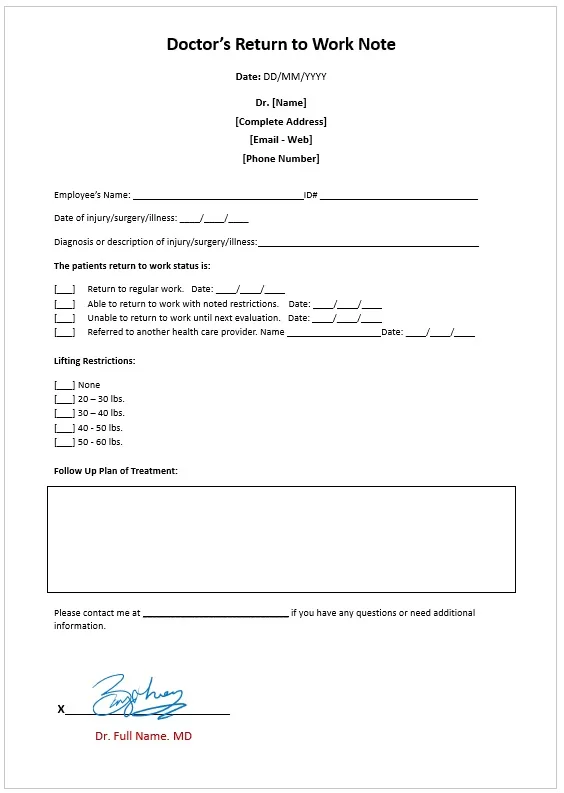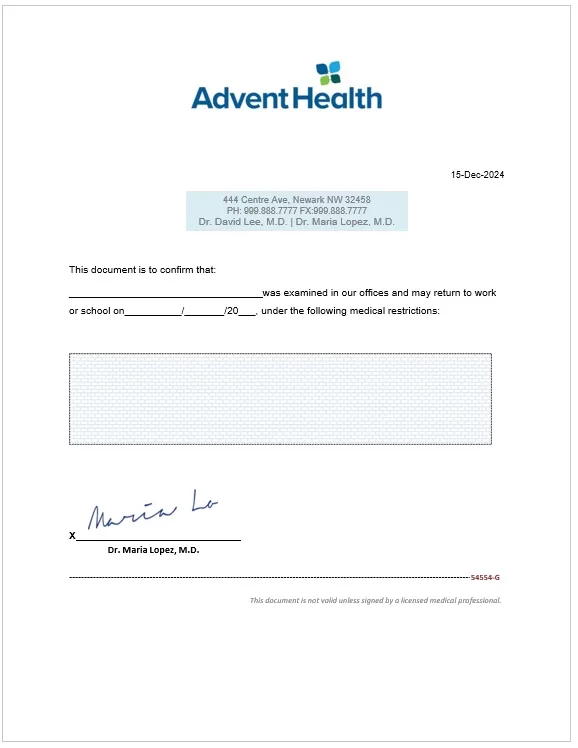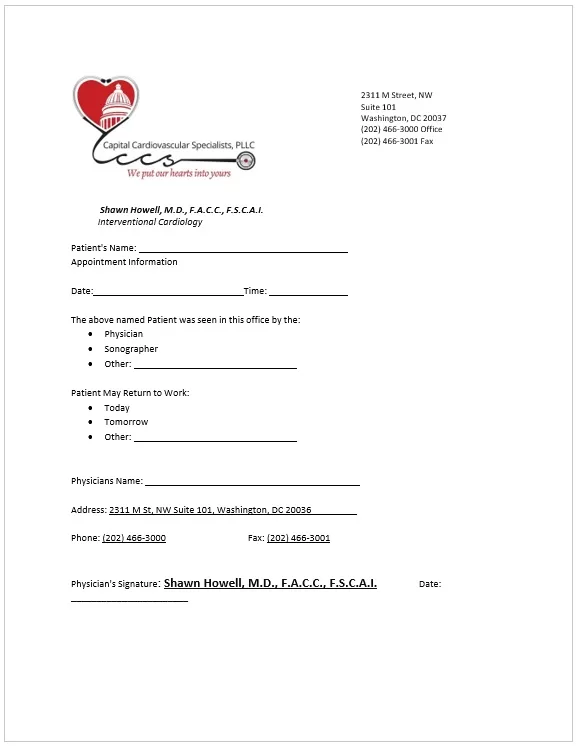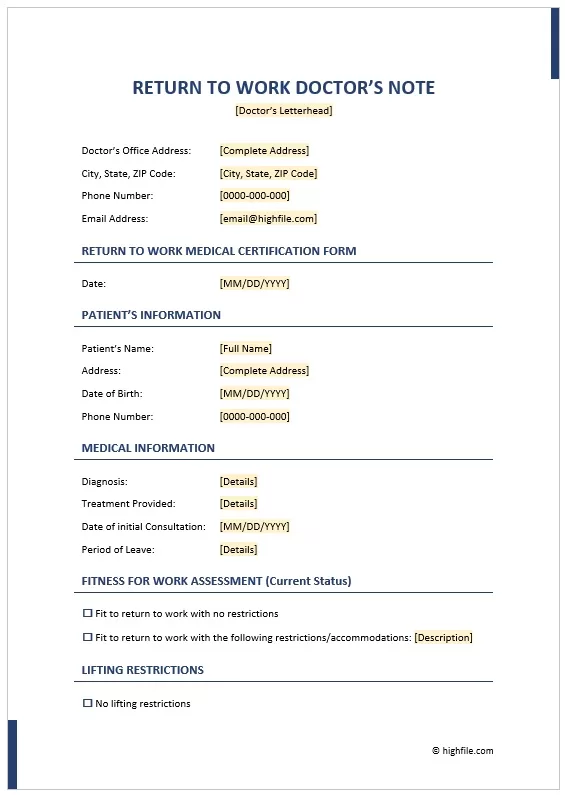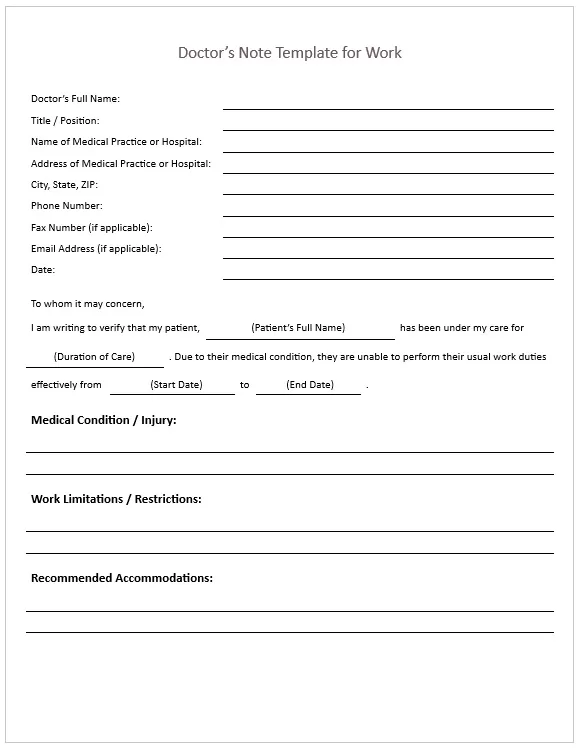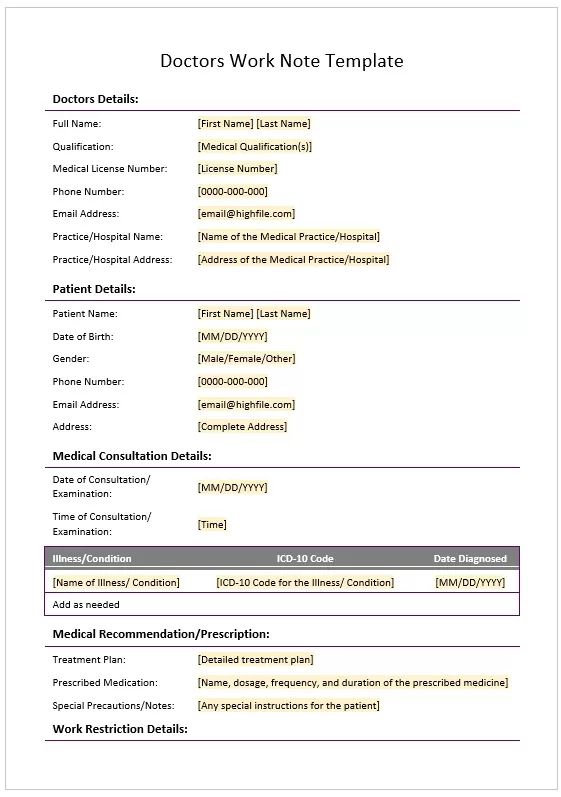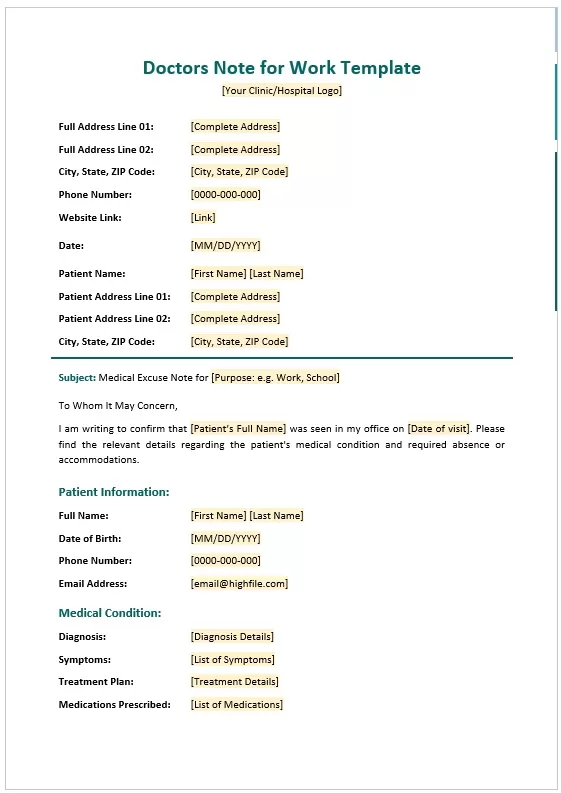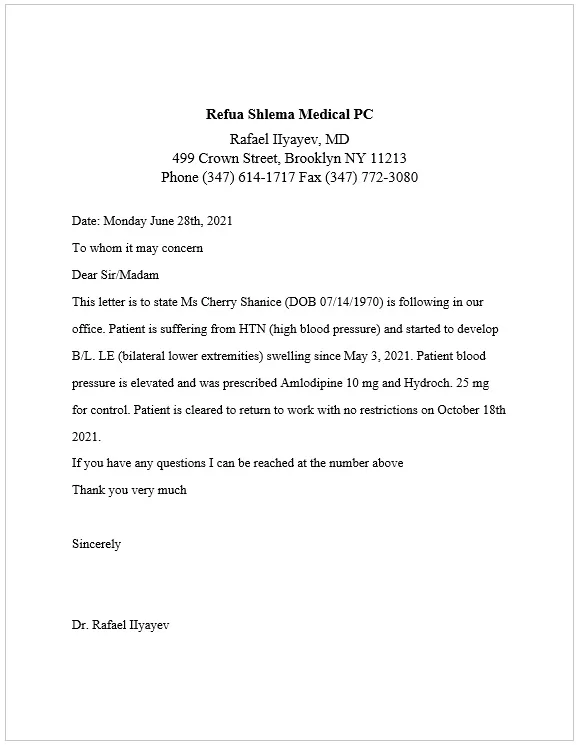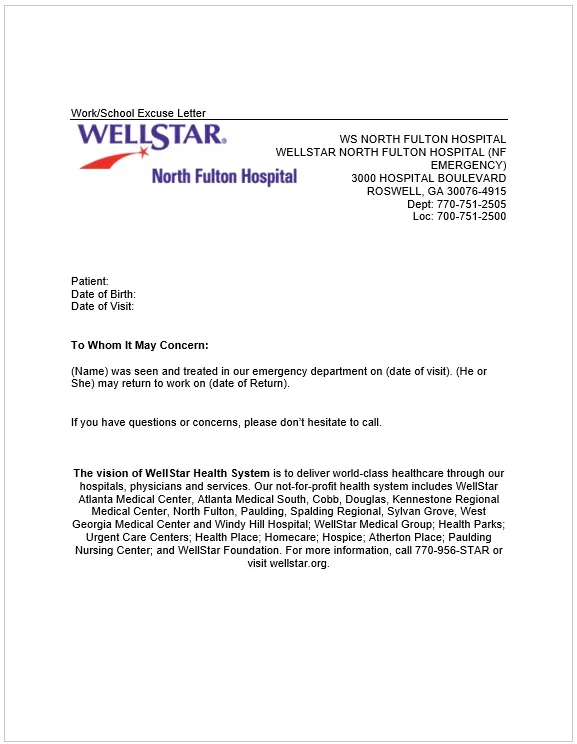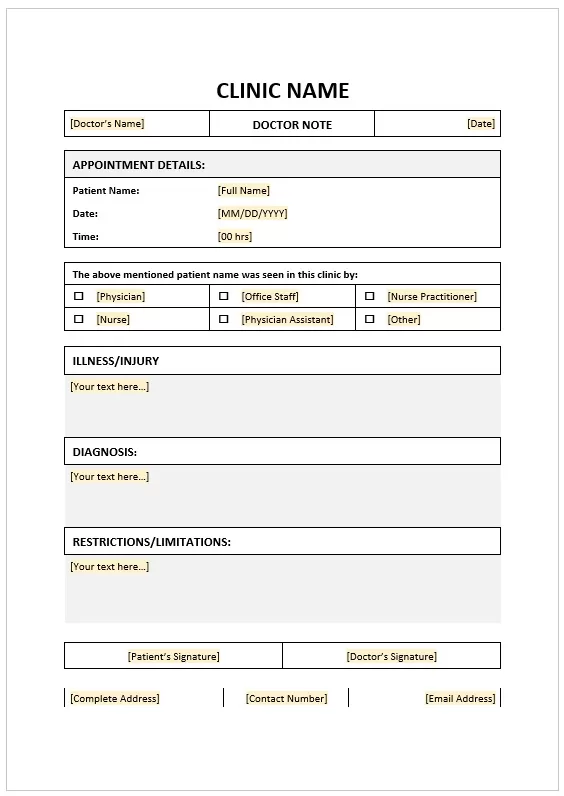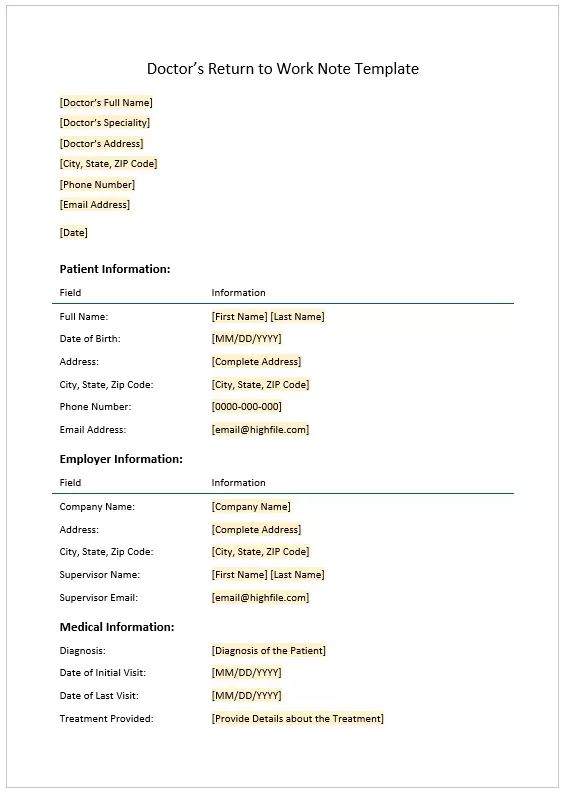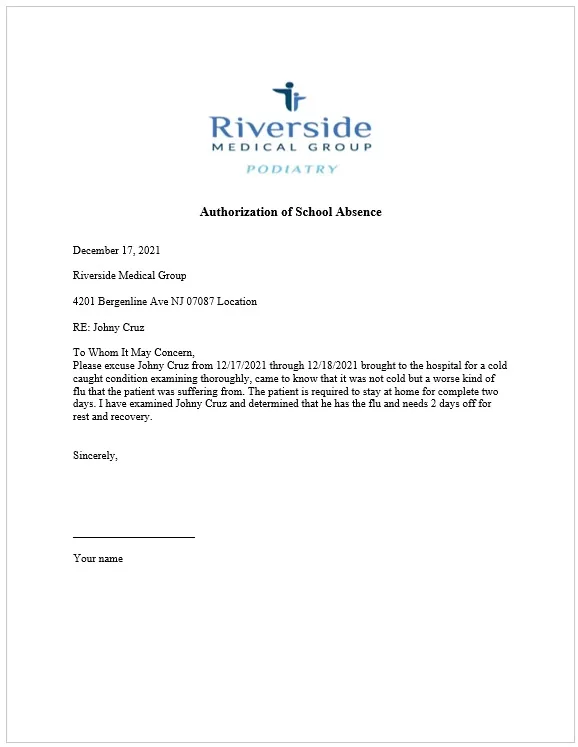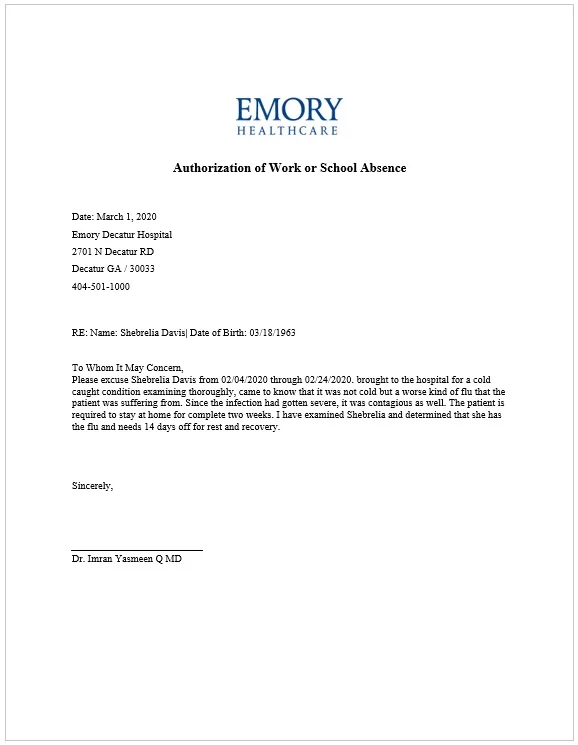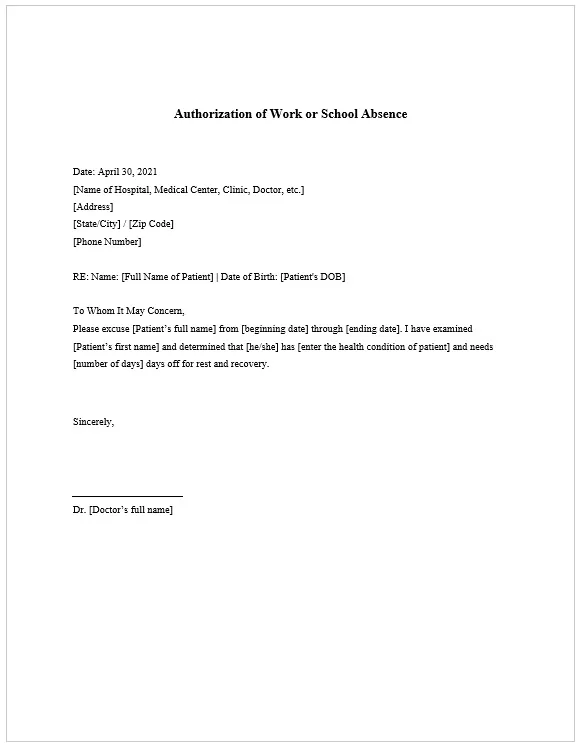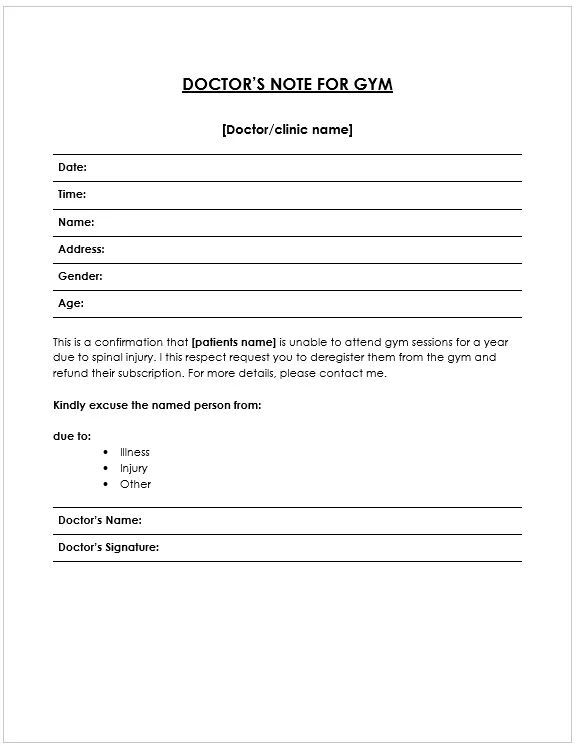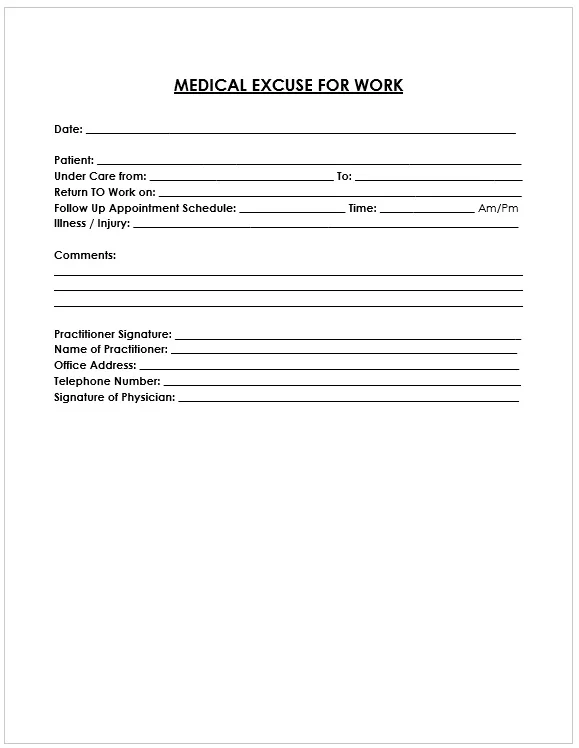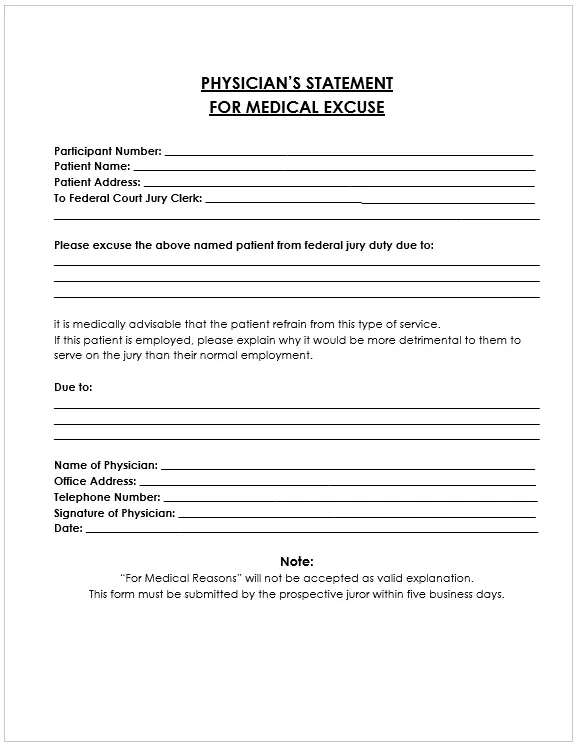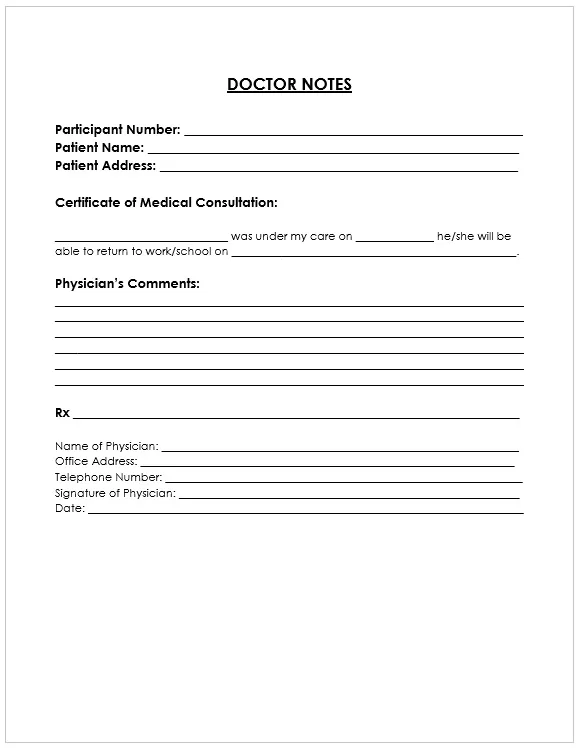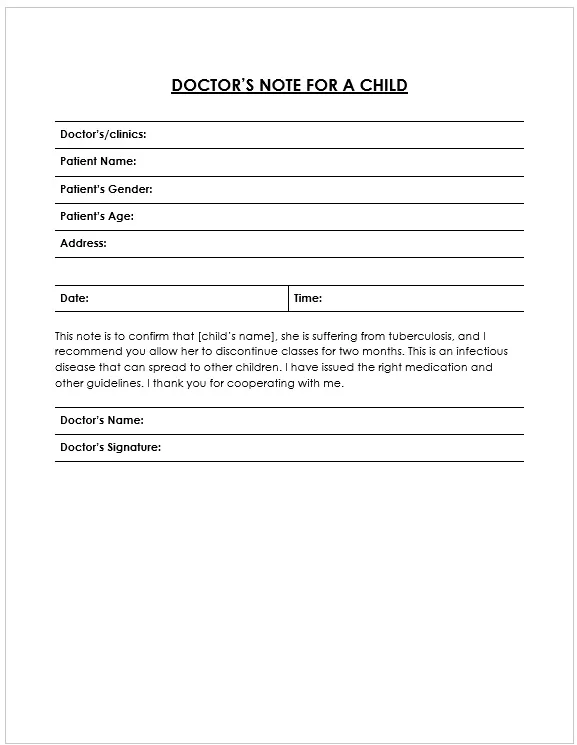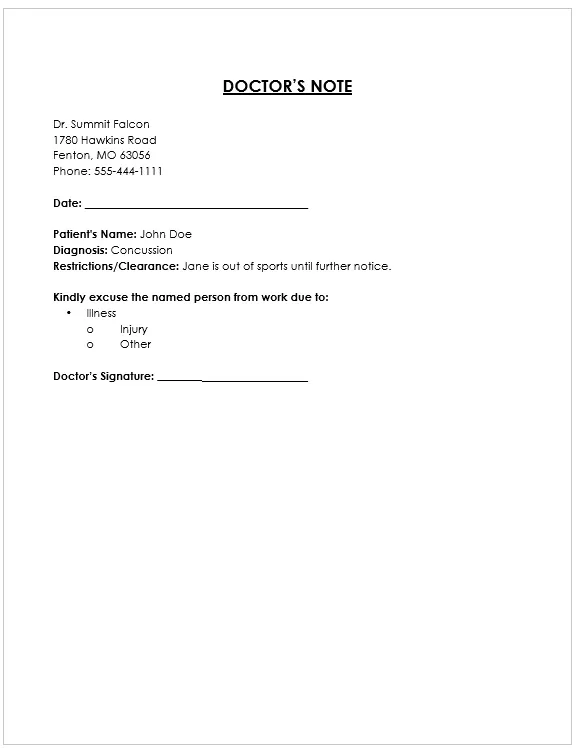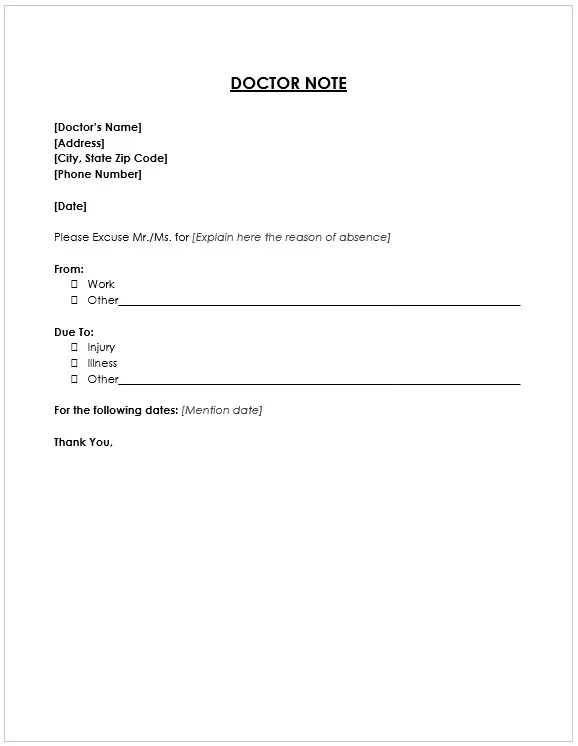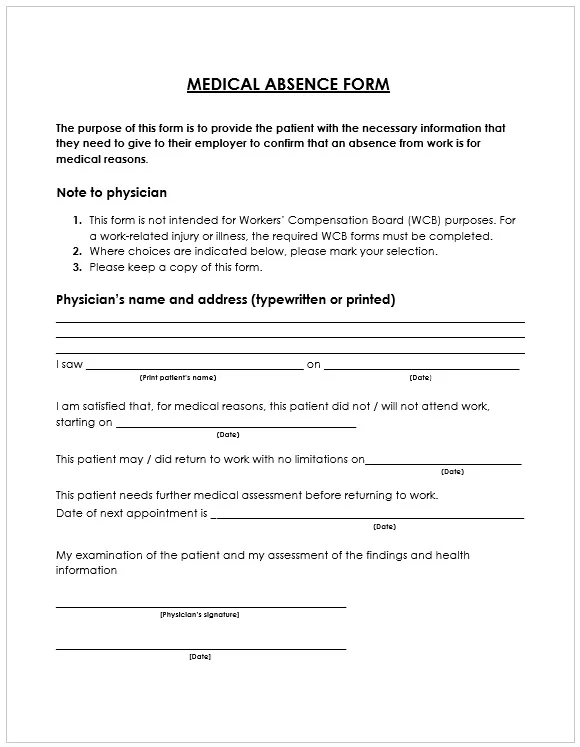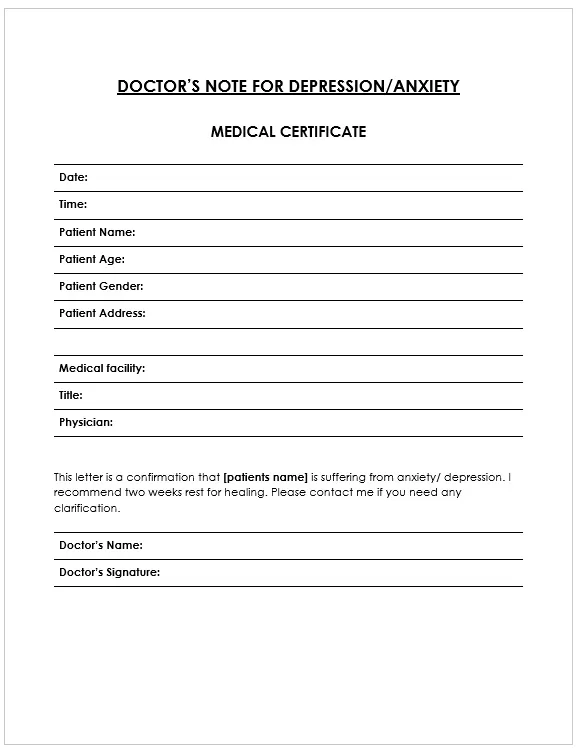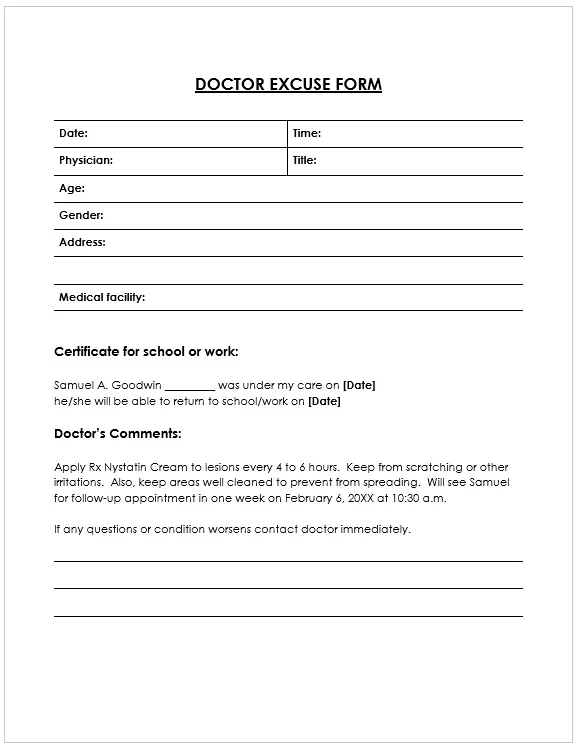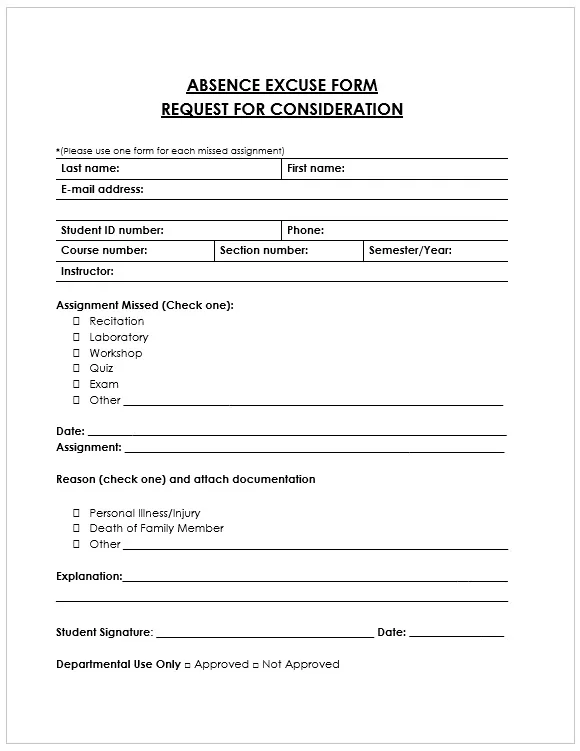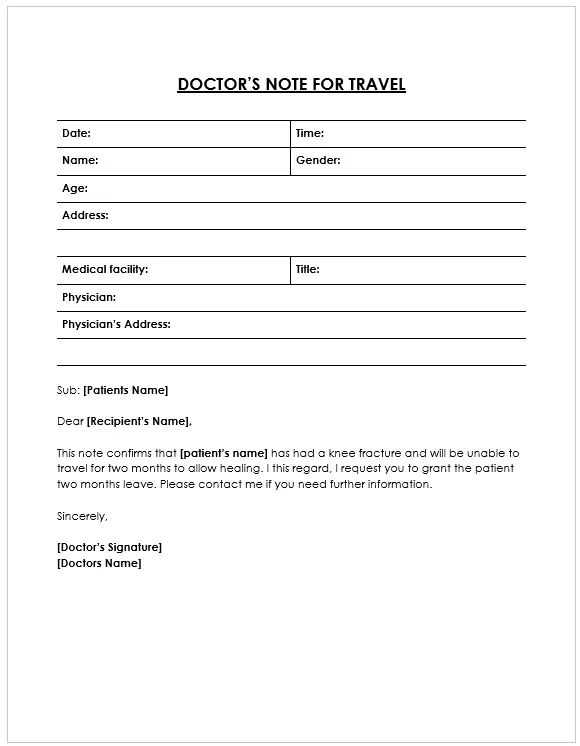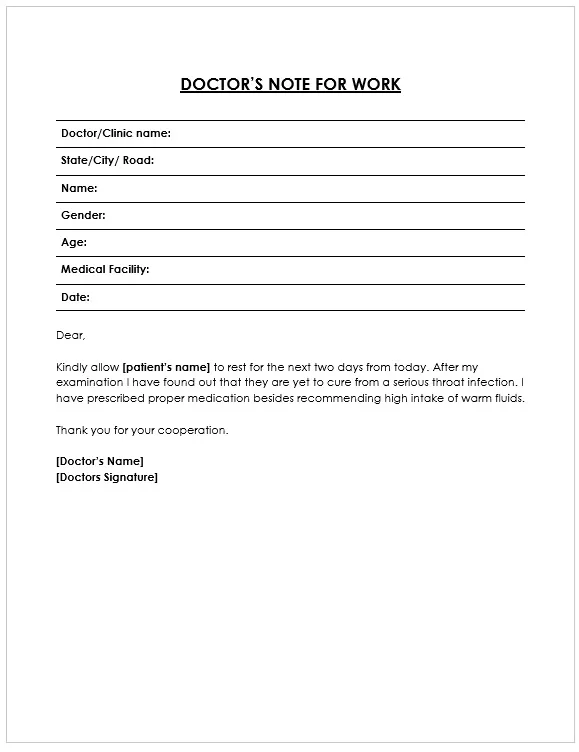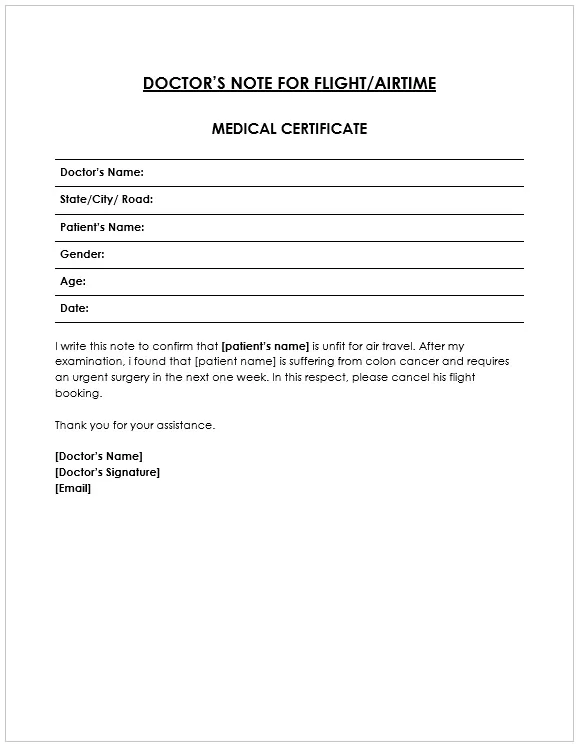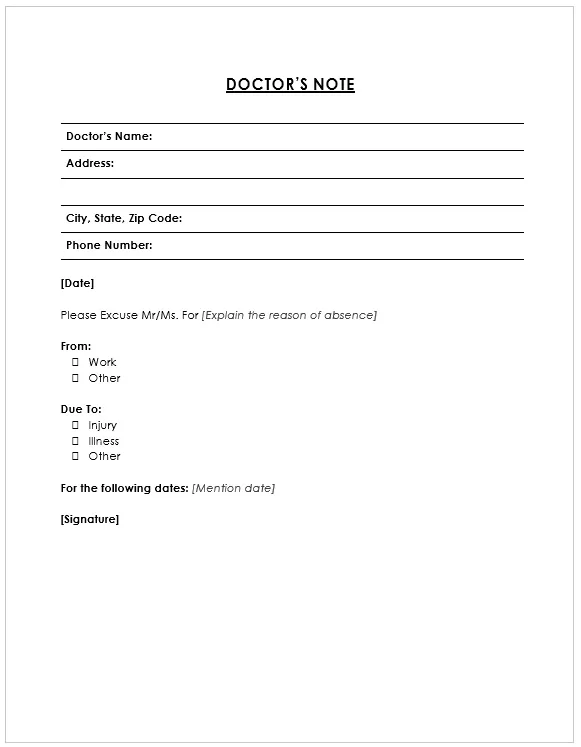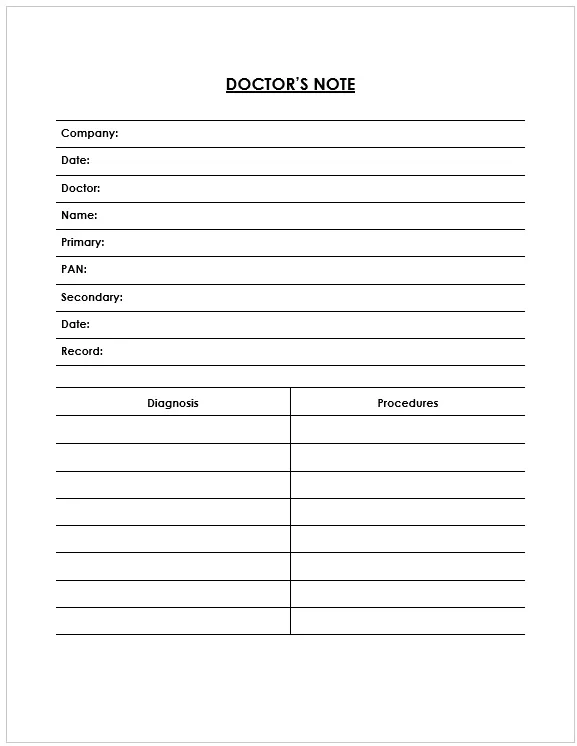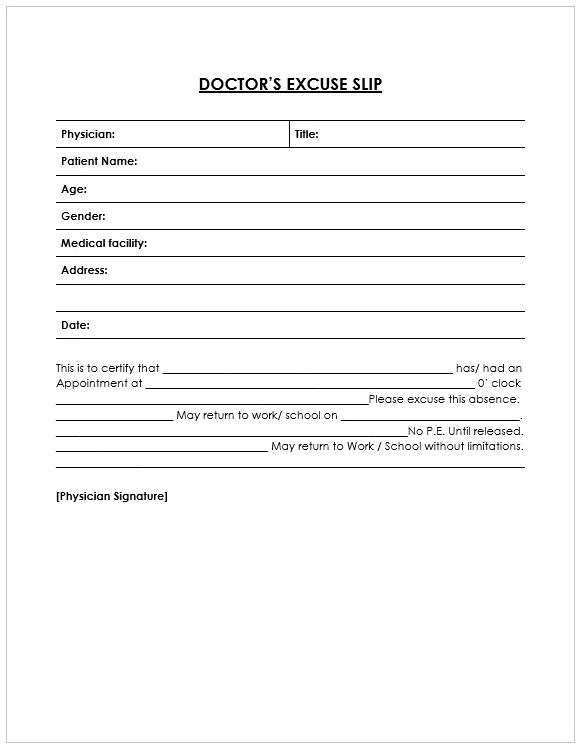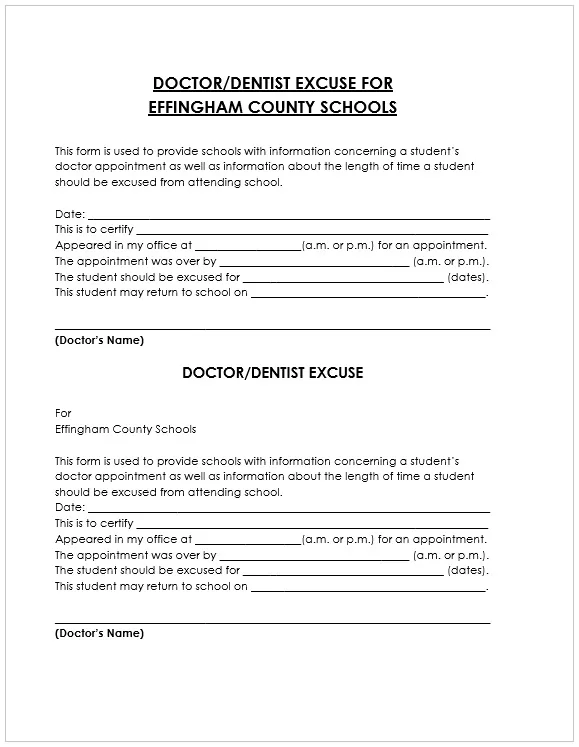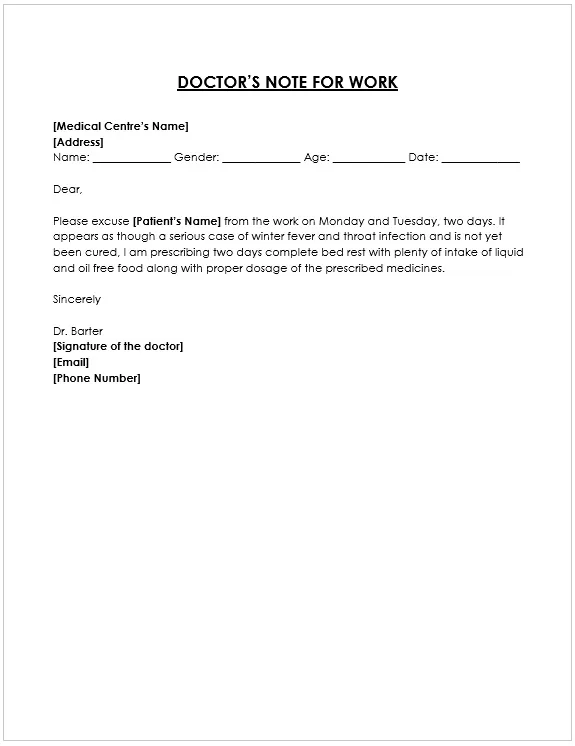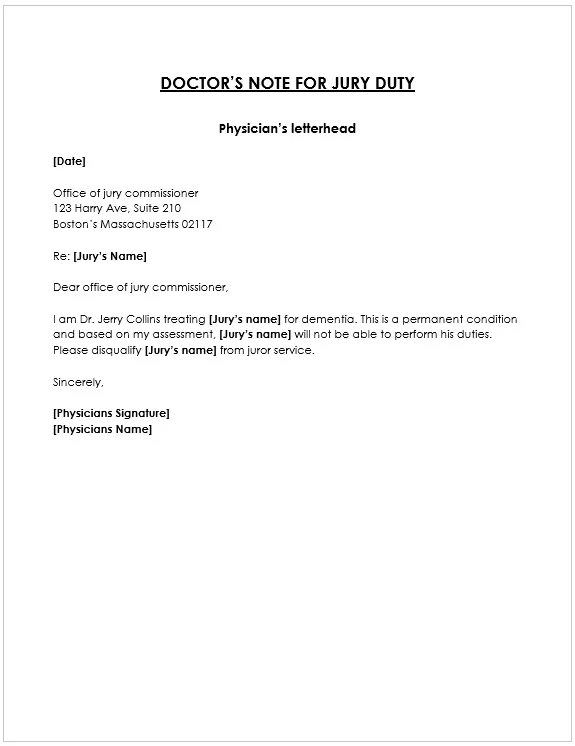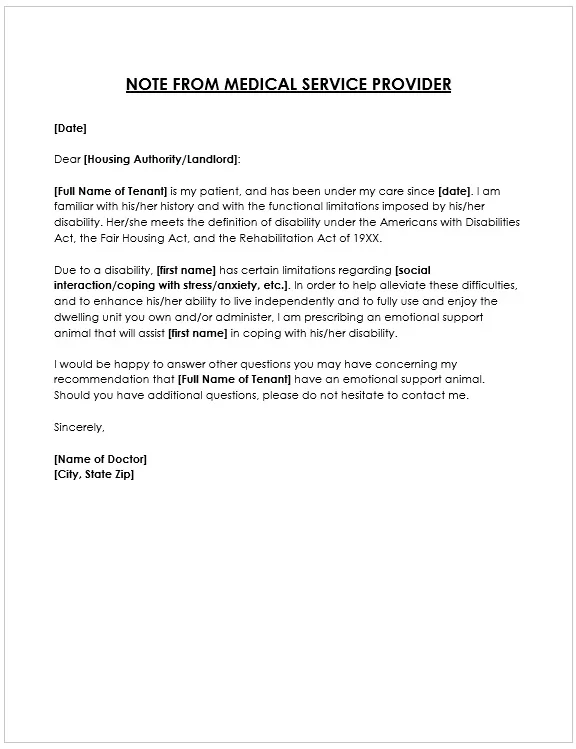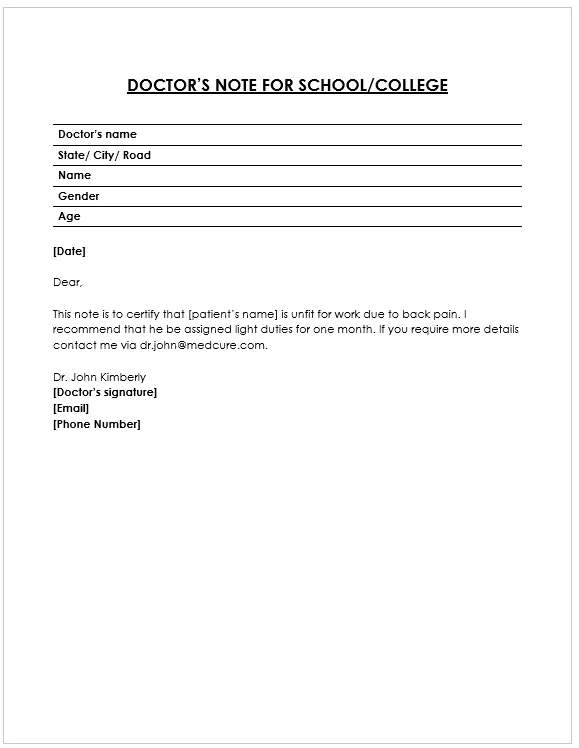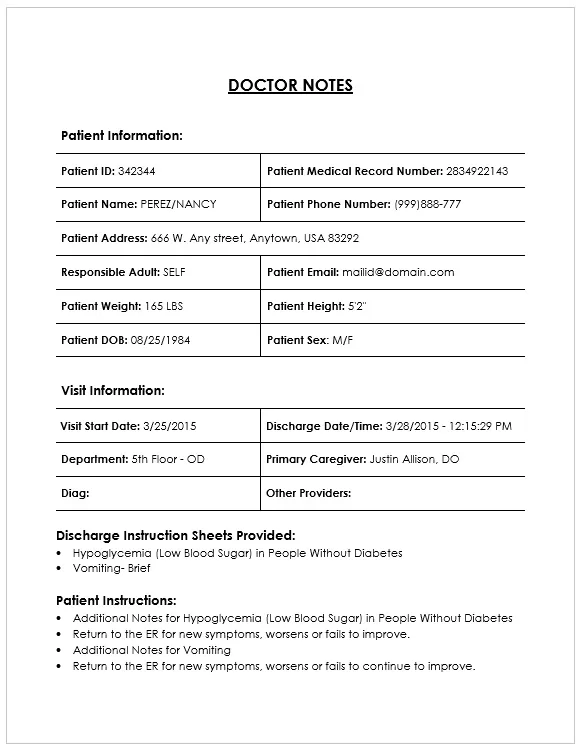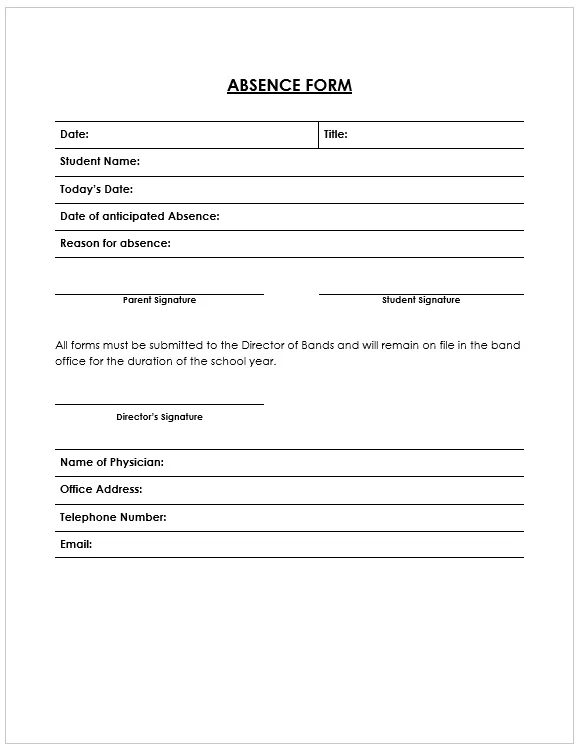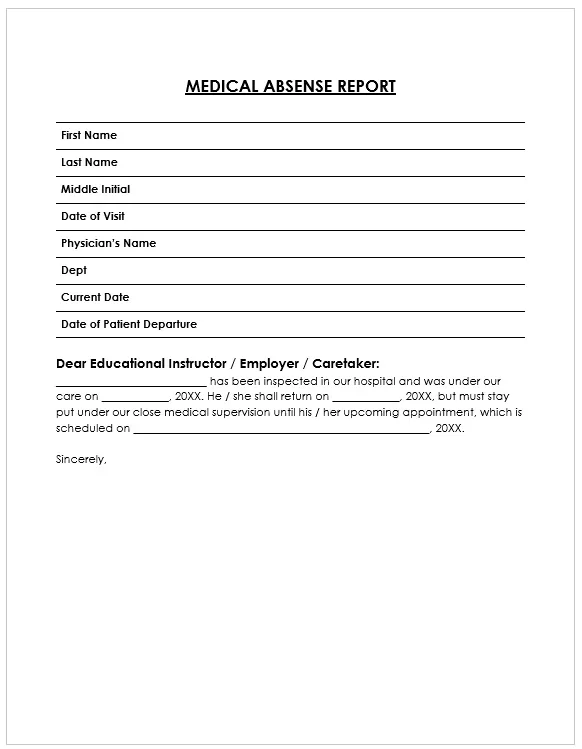Doctor’s notes which are additionally called medical excuse letters or statements of physicians, are documents that licensed health practitioners use to confirm that a patient is unwell and can deserve a break from work, school or any other duty. This is because it acts as an official document written by medical practitioners to organizations such as work places, schools, or judicial institutions enabling such organizations to appreciate absence and or any limitation as not self-imposed but rather medically imposed. You can also explore our collection of free Meeting Notes Templates and can use our BMI Calculator to help you manage your weight effectively.
Contents
- What is a Doctor Note?
- Importance in Professional and Educational Settings
- Key Components of an Effective Doctor’s Note
- Free Doctor’s Notes – Medical Excuse Forms, Slips and Examples
- Specialized Doctor Notes: Maternity Leave, Mental Health, and Sick Notes
- Common Scenarios Requiring a Doctor’s Note
- Doctor Notes: Return-to-Work or School Certifications
- Legal and Ethical Considerations
- Free Fake Doctor’s Note Templates
- Best Practices for Employers and Educational Institutions
- Author
What is a Doctor Note?
Usually, we know that a doctor notes the patient’s name, the date of the appointment, a brief comment or recommendation, and most importantly, the signature and name of the doctor. The aim of this piece of paper is generally geared towards excuses for absence related to health, declarations of rest, restrictions in body movements if necessary, and underwriters for a supporting work commitment. Whether in a sick note, fitting a sick leave or devoting amendments on best performance levels, such a doctor’s note is binding and at the same teeth gives coverage for the person that is being involved in the situation.
Importance in Professional and Educational Settings
In workplaces, doctor’s notes shield both the workers and the managers because they provide a valid explanation for their absence due to ill-health which is in line with the organization or the regulations of the country. We find such notes to be politely presented by the management of a school or a college for permission to miss lessons. The culture of availing such documents enhances the notion of responsibility, discourages falsification of sick leave and also embeds care for health as an integral part of the structure of organizations. With this said, most workplace doctor notes come from a professional angle explaining that it is alright to be absent because of health reason concerns or wittings.
Key Components of an Effective Doctor’s Note
A doctor’s note is a professional as well as a legally approved Stationery and therefore has to have a particular structure with certain requirements met else the purpose will be defeated. Such components enhance credibility, and make clear the necessary information and findings for the recipients, the employer, the school, or any authorities where the note will be assessed and acted upon medically. Its presence was unique. It must have caused even more misunderstandings, and rejections at teams peaks or administrative troubles as the Dr stated his notes and as they are still respected as a medical professional and complete copies.
Essential Elements:
At the core of an effective doctor’s note is the clear identification of the patient. This typically includes the patient’s full name and, in some cases, their date of birth or medical record number, especially in clinical environments. The note must also mention the date of the medical evaluation, as it helps verify the timeline of absence or health-related limitations. In many cases, the note will include a brief statement indicating that the patient was seen for a medical issue and is advised to refrain from specific activities or be excused for a certain period. While medical confidentiality must be preserved, general information about the medical necessity of the absence or restrictions should be clearly communicated.
Legal Considerations and Confidentiality
One of the most significant aspects of any doctor’s notes concerns the endorsement of a registered medical professional and their qualification, their address or written where the practice exists and license number or a signature. The processed doctors notes should be able to communicate the necessary information and at the same time, privacy governing laws such as HIPAA should be observed. Labeling these disclosures concerns does not solve the problem itself – rather it makes it even more important to provide such disclosures where necessary and to ensure that they remain dimensionally or contextually ethically valid.
Free Doctor’s Notes – Medical Excuse Forms, Slips and Examples
The general medical excuse note is the one which is frequently in use. It basically states that the concerned patient has visited a doctor, a requisite period of rest absence, or restriction of certain activities is suggested. Such notes are usually quite brief and contain few medical details; however, they specify the period of leave including beginning and end of the leave.
Medical Excuse Forms:
Medical Excuse Slips:
Medical Excuse Examples:
Specialized Doctor Notes: Maternity Leave, Mental Health, and Sick Notes
Some templates are tailored to specific medical circumstances, such as maternity leave notes, which provide confirmation of pregnancy and outline medical leave timelines before and after childbirth. Mental health notes may be used to excuse absences due to anxiety, depression, or therapy appointments, offering validation without breaching confidentiality. Templates for chronic illnesses or injuries often include longer timelines and may recommend accommodations or ongoing treatments.
Common Scenarios Requiring a Doctor’s Note
Doctor’s notes are utilized in many environments including professional, personal and academic areas to justify one’s absence due to illness, report any temporary restrictions, or meet any legal or policy regulation. The doctor notes fulfill the function of transparency, defending rights and services, and facilitates the correct recognition of medical conditions by organizations and employers.
Workplace Absences Due to Illness or Injury
The medical certificates from doctors are often requested the moment a worker has ever been away without official leave or was sick at home. Supervisors might ask for a medical certificate for the sake of verifying or rather justifying any and all leaves which may have been taken. This is particularly crucial in case of longer durations, chronic illness or when paid sick leaves are subject to business rules and policies. In jobs that require manual labor, doctor’s notes might be necessary for accommodating such individuals by either limiting the work they do or assigning different roles until they meet desired fitness levels.
School or Academic Leave for Health Reasons
Colleges and schools always practice the policy of obtaining doctor’s notes for students who fail to attend school due to sickness, accidents, or any medical reasons in order to excuse such students. Regardless if it is a simple one day absence for a cold or a number of days’ absence after a surgery, these terms must be articulated in records brought to school to excuse school disattend and facilitate learning delivery. Another instances students might also use history of sickness to justify missing exams or applying for home learning.
Fitness-for-Duty Certifications and Return-to-Work Clearances
Doctor’s notes are issued in offices only when the employees missed a number of consecutive days of their responsibility due to some serious health condition. It is important to confirm that the employee is able to perform all the tasks necessary for his/her job and it is safe for him/her to do so. In the same manner, doctor notes are issued in schools or sports centers to allow students and athletes to go back to normal activities on the basis that it is not harmful to their health. Doctor note is the medical check that such institutions rely on for their schedules and procedures, which affect the health of individuals.
Doctor Notes: Return-to-Work or School Certifications
There are numerous instances when return-to-work templates are applied, which confirm a satisfactory convalescence, namely one that enhances one’s likelihood of returning to duty in either employment or educational institutions. Usually, these templates will also specify if there are any restrictions still in place, or if the applicant is approved to perform without limitation. It is very important to choose the appropriate template, this way the note will serve the purpose for which it was written, and will be acknowledged by the organization it is submitted to.
Legal and Ethical Considerations
Doctor’s notes are legal documents; hence, utmost care should be exercised in their issuance, utilization, and storage to ensure compliance with medical ethics and statutory regulations. On the surface, the explanation for a doctor’s note seems simple and straightforward; however, these notes bear immense legal ramifications when they are introduced in institutions like schools, workplaces, and courts. Abuse, false representation, and unwarranted issuance of doctor’s notes will expose both the physician issuing it and the person presenting it to disciplinary action and legal prosecution.
Understanding the Legal Implications of Issuing and Using Doctor’s Notes
No physician would ever issue a doctor certificate without being duly licensed to practice medicine, and there should be an actual medical evaluation for a doctor certificate to be authentic. Forging or misusing an unauthorized doctor’s note constitutes fraud, for which punishments may include disciplinary action, fines, or prosecution. Institutions also have the right to check the authenticity of a suspected note, especially if it involves insurance claims, employee leave benefits, or exemptions by law.
Consequences of Falsifying Medical Documents
It constitutes forgery and fraud to alter or forge a medical note. Such misconduct would violate workplace or academic codes and may exist as a criminal offense. Those caught using fake notes could be expelled, released from duty, or even face lawsuit charges. In the same way, any healthcare professional issuing notes without the proper diagnosis or supervision may undergo suspension of their license or a malpractice suit.
Maintaining Patient Confidentiality and HIPAA Compliance
In the U.S. doctor’s notes, of course, must also be HIPAA compliant. While providing information that supports the necessity for leave or accommodation, either type of note should leave out extraneous details concerning the patient’s medical condition unless the patient gives explicit consent for this information to be released. The healthcare provider’s ethical responsibility in ensuring properly documented requests, in conjunction with the confidentiality of such evidence, constitutes the key balancing act.
Free Fake Doctor’s Note Templates
A fake doctor’s note is a counterfeit or forged piece of paper that falsely certifies that a licensed medical professional has issued its document, mostly to justify an absence from work, school, or other engagements. For an original doctor’s note, a real medical exam had been conducted, and it is signed by a qualified healthcare practitioner. On the other hand, falsified notes are usually issued without actual examination or medical grounds. With the intention to mislead or deceive an employer, school, or court of law, this elaborate ruse is meant to grant permission for leave or some benefits.
Why People Use Fake Doctor’s Notes
People might use fake doctor’s notes to avoid penalties for not attending work, obtain benefits during sick leave, postpone assigned activities or exams, or obtain time off without having to apply for official leave. Some websites might allow people to download what are called fake templates that closely resemble an actual format and language that makes it seem very real- usually customizable enough to be able to appear convincing.
Ethical and Legal Implications
Using a fake doctor’s excuse may be small potatoes to some; however, fraudulent behavior is behind it, and it carries consequences. Presenting a false medical notice is deceiving and may violate work or school policies. In worse instances, this may be considered document forgery, which is a criminal offense in several states. Job termination, suspension from school, or penalties can be consequences.
Risks to Employers and Institutions
The fakes doctor notes are very much detrimental to the trust that an employer and institution must have in the working place. Its administrative work becomes burdened and messed up planning for the workflow. Thus, such organizations always reserve the rights verifying the authenticity of a note and follow up with conditioning by way of suspected misuse. Some may contact the medical office mentioned on the note or ask for proof documentation to verify integrity.
Best Practices for Employers and Educational Institutions
While employers and educating institutions have major roles within the context of administering and verifying doctors’ notes tendered by their employees or students, these notes provide formal proof as to why an individual was absent for health reasons, and how those notes are handled could become a deciding factor for organizational integrity, employee satisfaction, and legal compliance. The best policies that are clear and consistent will therefore safeguard the interests of the institution and the confidentiality of those that submit such notes.
Establishing Policies for Accepting and Verifying Doctor’s Notes
The first step for any organization would be to have a formal, written policy that specifies instances when a doctor’s note will be required and what grounds a note must have in order to be accepted as valid. Employers and schools should specifically provide information on the acceptable time frame for submission, what types of healthcare provider are accepted, and whether follow-up documentation will be required for absences that are longer than a few days. This policy should be included in employee handbooks, student codes of conduct, or HR guidelines so as to maintain transparency and consistency.
Also, institution should set in place a standard procedure for verification of any questionable notes or notes of suspicion. So, they might be calling the medical office on which the document is issued to verify the appointments without violating any privacy rules. Verification should never include requesting specific medical information, the reason being that it could be construed as a breach of patient confidentiality regulations, like HIPAA in the U.S.
Balancing Trust and Verification Processes
Verification in some cases is important, but it is equally vital that a culture of trust is allowed to flourish. Automatically suspecting academic dishonesty can not only demoralize but can strain the work/school relationship. Each case should start from a neutral position, acknowledging that the majority of individuals will submit honest documents. Instead, a verification process designed to be non-confrontational will keep the mutual respect intact.
Handling Sensitive Medical Information Appropriately
Any documents containing medical information should be stored in a secured environment and should be accessible only by authorized persons. Institutions will have to train their personnel for the handling of these records in compliance with privacy laws and internal data security mechanisms. Other best practices relate to limiting the retention of such documents for as long as is legally or operationally justifiable. In the professional and discreet handling of doctor notes, institutions can therefore harmonize legal compliance and ethical responsibility.

